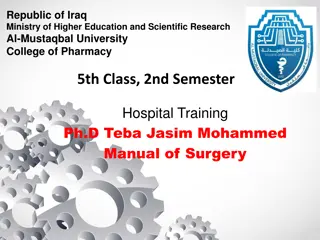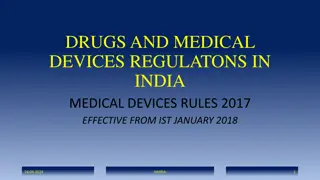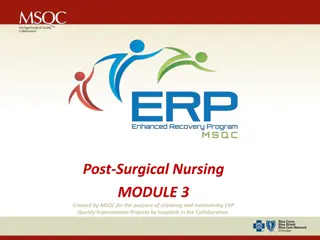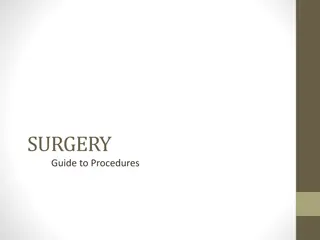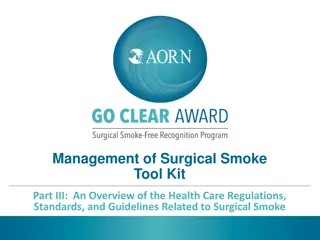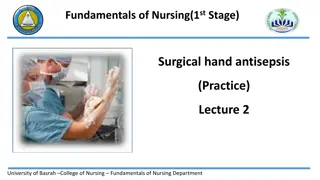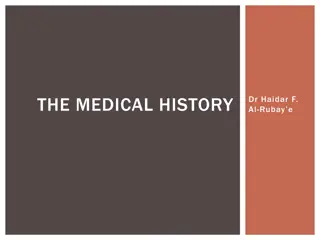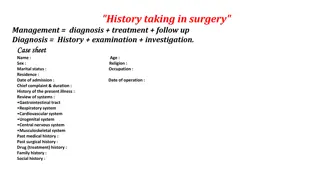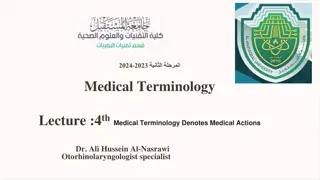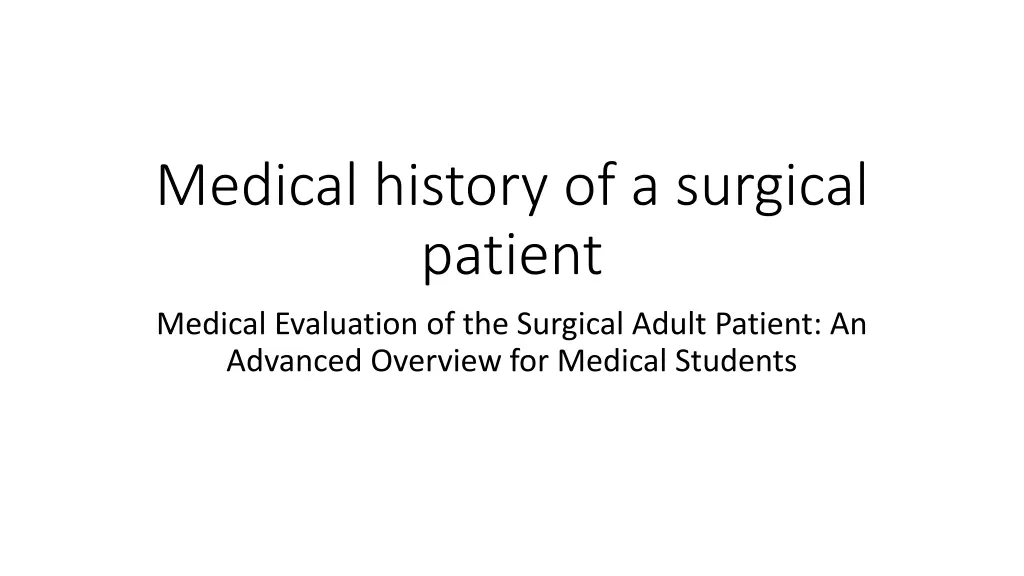
Key Elements of Surgical Patient Medical Evaluation
"Learn about the critical steps involved in the medical evaluation of adult surgical patients, including obtaining a comprehensive medical history to assess risks and optimize outcomes. Explore key elements such as understanding the indication for surgery, past medical history considerations, and the impact of various health conditions on perioperative care."
Download Presentation

Please find below an Image/Link to download the presentation.
The content on the website is provided AS IS for your information and personal use only. It may not be sold, licensed, or shared on other websites without obtaining consent from the author. If you encounter any issues during the download, it is possible that the publisher has removed the file from their server.
You are allowed to download the files provided on this website for personal or commercial use, subject to the condition that they are used lawfully. All files are the property of their respective owners.
The content on the website is provided AS IS for your information and personal use only. It may not be sold, licensed, or shared on other websites without obtaining consent from the author.
E N D
Presentation Transcript
Medical history of a surgical patient Medical Evaluation of the Surgical Adult Patient: An Advanced Overview for Medical Students
Introduction Introduction The medical evaluation of the adult surgical patient is a critical step in ensuring safe and effective surgical management. It requires an in- depth understanding of the patient s medical history, current clinical status, and the potential risks associated with surgery. This process is integral to the formulation of a perioperative plan and the optimization of patient outcomes. A comprehensive preoperative evaluation not only identifies the need for medical interventions but also serves to mitigate potential complications during and after surgery.
1. Comprehensive Medical History 1. Comprehensive Medical History The foundation of any medical evaluation lies in obtaining a detailed and systematic medical history. This provides the clinician with insights into the patient s overall health, previous surgical experiences, comorbidities, medications, and psychosocial factors that may influence the surgical outcome.
Key Elements of the Medical History: Key Elements of the Medical History: Present Illness Understanding the indication for surgery is paramount. This includes: Nature and Duration of Symptoms: For instance, in a patient scheduled for cholecystectomy, questions related to the frequency, intensity, and duration of symptoms like biliary colic or jaundice are crucial. Impact on Daily Function: Understanding how the condition affects daily activities can help in decision-making regarding the urgency of the procedure.
Past Medical History (PMH) Past Medical History (PMH) Cardiovascular Diseases: Detailed inquiry about hypertension, coronary artery disease, congestive heart failure (CHF), arrhythmias (e.g., atrial fibrillation), and previous myocardial infarction (MI). These are relevant for assessing perioperative risks of anesthesia and surgical complications like bleeding or thromboembolic events. Respiratory Diseases: Chronic obstructive pulmonary disease (COPD), asthma, or obstructive sleep apnea (OSA) can complicate intubation and postoperative recovery, particularly with regard to oxygenation and ventilation.
Endocrine Disorders: Diabetes mellitus (DM) can affect wound healing and increase infection risk. Thyroid disorders (hyperthyroidism or hypothyroidism) may alter metabolic Renal and Hepatic Function: Chronic kidney disease (CKD) or liver cirrhosis requires careful evaluation of drug metabolism, fluid balance, and the potential need for dialysis postoperatively. Neurologic Disorders: A history of stroke, seizures, or neuropathies may have implications for anesthesia management and post-surgical rehabilitation.
Surgical History Surgical History Understanding prior surgical interventions is essential. This includes complications from previous surgeries such as infections, adverse reactions to anesthesia, or difficult wound healing. The patient s history of previous anesthesia, particularly any issues such as malignant hyperthermia or postoperative nausea and vomiting (PONV), should also be documented.
Medications and Allergies Medications and Allergies A detailed list of all current medications, including over-the-counter drugs, herbal supplements, and vitamins, is necessary to assess potential drug interactions, risks of bleeding, and anesthetic concerns. For example, the use of anticoagulants (warfarin, dabigatran) or antiplatelet agents (aspirin, clopidogrel) must be addressed, as these may require temporary discontinuation prior to surgery. Allergies to medications, latex, or contrast media must be explicitly noted.
Family History This can provide critical insight into hereditary conditions that may impact surgery. Family history of anesthetic complications (e.g., malignant hyperthermia), clotting disorders (e.g., hemophilia, factor V Leiden), or certain cancers may alter the surgical and anesthetic approach. Social History Social determinants of health play a crucial role in postoperative recovery. Assessment of smoking history, alcohol consumption, and illicit dru wound healing, infection rates, and the risk of anesthesia complications. Furthermore, social support and the ability of the patient to comply with postoperative care should be assessed.g use is vital, as these habits can affect
Review of Systems (ROS) Review of Systems (ROS) A systematic review of systems can uncover undiagnosed conditions that may impact surgery, such as undiagnosed diabetes, sleep apnea, or active infections. Specific attention should be paid to: Cardiovascular system: Chest pain, shortness of breath, palpitations. Respiratory system: Cough, dyspnea, wheezing. Gastrointestinal system: Nausea, vomiting, changes in bowel habits.
Physical Examination Physical Examination The physical examination should be comprehensive and targeted, with particular emphasis on identifying any findings that may influence surgical planning or anesthetic management. General Appearance Assess the patient's overall nutritional status (e.g., obesity, cachexia), hydration, and signs of systemic illness such as fever or pallor. Evaluate for signs of systemic infection (e.g., fever, tachycardia, hypotension).
Cardiovascular Examination Perform auscultation for murmurs, arrhythmias, or other abnormal heart sounds. Assess for peripheral edema, which may suggest congestive heart failure or poor cardiac output. Measure blood pressure in both arms to assess for signs of vascular disease or coarctation of the aorta. Respiratory Examination Inspect for signs of respiratory distress, such as use of accessory muscles, and auscultate for wheezes, crackles, or reduced breath sounds, which may indicate COPD, asthma, or pneumonia. Evaluate oxygen saturation levels and consider preoperative pulmonary function tests (PFTs) if indicated.
Abdominal Examination Palpate for tenderness, masses, or organomegaly. For example, in a patient presenting for abdominal surgery, assess for signs of peritonitis or bowel obstruction. Perform a digital rectal exam if indicated (e.g., for colorectal surgeries). Neurologic Examination Evaluate mental status, cranial nerve function, motor and sensory function, and coordination. This is particularly important for patients undergoing neurosurgery or those with a history of cerebrovascular disease.
Preoperative Investigations Preoperative Investigations Based on the history and physical examination, select appropriate laboratory and imaging investigations to evaluate the patient's baseline status and assess for undiagnosed conditions.
Laboratory Tests Laboratory Tests Complete Blood Count (CBC): Assess for anemia, infection, or clotting abnormalities. Electrolytes, Renal Function, and Liver Function Tests: To evaluate metabolic status and organ function. Coagulation Profile (PT, PTT, INR): To assess bleeding risk, particularly in patients on anticoagulants or those with liver disease. Blood Glucose: Especially in diabetic patients to ensure optimal glycemic control Arterial Blood Gas (ABG): In patients with respiratory or cardiovascular concerns. Urinalysis: To assess for urinary tract infections or signs of kidney dysfunction.
Imaging Studies Imaging Studies Chest X-ray: For patients with respiratory symptoms or those undergoing thoracic or abdominal surgery. Electrocardiogram (ECG): For patients over 40 years old, or those with known cardiovascular disease. Abdominal Ultrasound or CT Scan: For patients with abdominal symptoms (e.g., gallstones, appendicitis). Echocardiogram: If there are concerns for valvular heart disease or poor cardiac function.
Anesthetic Considerations Anesthetic Considerations A multidisciplinary approach involving anesthesiologists is essential to ensure optimal perioperative care. Preoperative anesthetic assessment should include: Airway assessment: Evaluate for difficult intubation (e.g., Mallampati score). Anesthetic history: Any adverse reactions to previous anesthetic agents. Perioperative analgesia plan: Including regional versus general anesthesia.
5. Risk Stratification 5. Risk Stratification Risk stratification is central to the preoperative assessment, helping to predict the likelihood of complications. Tools such as the American Society of Anesthesiologists (ASA) Physical Status Classification and the Revised Cardiac Risk Index (RCRI) can assist in assessing overall surgical risk.
Conclusion Conclusion A thorough medical evaluation of the adult surgical patient is critical for ensuring optimal outcomes and minimizing risks. The medical history, physical examination, and appropriate investigations provide the data necessary to plan and prepare for surgery, tailor anesthetic management, and identify any interventions needed to improve the patient s preoperative condition. As future clinicians, medical students must develop a systematic approach to assessing surgical patients, integrating all relevant data to deliver safe, evidence-based care.
Selected Bibliography Selected Bibliography Harrison's Principles of Internal Medicine (20th ed.). J. Larry Jameson, et al. McGraw-Hill, 2018. Cecil Medicine (25th ed.). Lee Goldman, et al. Elsevier, 2016. Essentials of Surgical Practice. S.D. Moulton. Wiley-Blackwell, 2015. Current Diagnosis and Treatment in Surgery. Gerard M. Doherty. McGraw-Hill, 2021. Surgical Patient Care: A Clinical Handbook. Charles R. Hobson, 2016. Springer.

